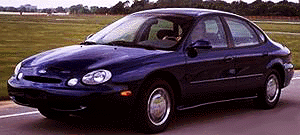Ford Taurus GL (1996)
1996 FORD TAURUS GL SEDAN

by: CAREY and BILL RUSS
SEE ALSO: Ford Buyer's Guide
To say that the launch of the 1996 Ford Taurus is one of the most important in the company's history would not be an understatement. It has certainly been the biggest in terms of advertising and publicity, and for good reason. The Taurus is Ford's core passenger car. Since the introduction of the original version ten years ago, it has consistently been among the top-selling automobiles in the country, often being number one. That first-generation Taurus was revolutionary in many ways, but ten years is a long time. Success does not stay with those who rest on their laurels.
The second-generation Taurus is both evolutionary and revolutionary. The styling is certainly very different, even revolutionary. Underneath and inside, the Taurus is still a Taurus, only better. It is a bit larger and more spacious. Nearly all parts are new or upgraded. Customer input determined many changes, and lessons learned and techniques devised during the 38-month gestation period will provide a solid foundation for new product development in Ford's future.
The 1996 Taurus is available as a sedan or station wagon in two models, GL and LX. The GL uses an upgraded version of the 3.0-liter Vulcan V6 engine, while the LX is fitted with a more powerful 3.0-liter dual overhead cam Duratec V6 that is a close relative to the 2.6-liter V6 found in the Contour. We spent a week around home with a GL sedan and some more time in an LX in the Charlotte, NC area and were impressed.
APPEARANCE: When introduced, the 1986 Taurus seemed so round, sleek, and aerodynamic. Suddenly it looks as boxy and angular as the cars it replaced. Although it is longer and wider than the car it replaces, the new Taurus looks smaller, a testament to its proportions. The base of the windshield was moved forward, the hood line is lower and there is 28% more glass area than before for better visibility. The predominant styling theme is the oval. There are few straight lines on the car. The Ford designers have made a bold statement that cannot be ignored, and the Taurus stands out on the road.
COMFORT: The interior of the 1996 Taurus is completely new but still familiar. The increased length and width combined with greater window area make for a larger interior that feels even more spacious. The velour-covered seats and instrument panel are similar to those of the previous generation, with detail improvements. The most notable interior improvement concerns the controls for the climate control and sound systems. They are now placed together in an oval (of course) panel in the center of the dashboard. These important controls are now much easier to use.
Also new and useful on cars with a steering column-mounted shift lever is a multipurpose center console that can fold into a third front passenger seat. Rear seat passengers have plenty of room, and the rear bench seat folds down with a 60/40 split if long cargo items must be carried. Trunk access is much easier thanks to a lower liftover height. Common convenience items such as power-operated seats, windows, door locks, and mirrors are standard or optional depending on trim level and option package.
SAFETY: A safety-cage type chassis with deformable crush zones, dual air bags, 3-point safety belts for outboard and center rear-seat passengers, and available antilock brakes help make the 1996 Taurus a safe automobile.
ROADABILITY: Thorough testing, analysis, and engineering during the design phase has resulted in a chassis structure that is much more rigid than before. Virtually eliminating unwanted flexing, this makes for better suspension control, less road noise, and fewer annoying squeaks and rattles. The suspension has been redesigned with the result that the highway ride is comfortable yet controlled. A chance to drive on the infield road course at Charlotte Motor Speedway showed that handling and maneuverability are very good, indeed.
PERFORMANCE: Standard engine in the 1996 Taurus GL is the 3.0-liter Vulcan V6. This 145- horsepower pushrod engine has been extensively redesigned for quieter and smoother operation and better fuel economy. Driving the front wheels through a sophisticated four-speed electronically- controlled automatic transmission, the Vulcan provides enough power for any family-car application. Folks who want more power can opt for the 200-horsepower Duratec V6 in the Taurus LX models.
CONCLUSIONS: The original Ford Taurus was a significant automobile when it was introduced 10 years ago. The 1996 Ford Taurus should make as much of an impact on the automotive scene today.
SPECIFICATIONS:
1996 FORD TAURUS GL SEDAN
Base Price $ 18,600
Price As Tested $ 20,560
Engine Type V-6, ohv - pushrod, sefi*
Engine Size 3.0 liter/181 cid
Horsepower 145 @ 5200
Torque (lb/ft) 170 @ 3250
Wheelbase/Length 109"/198"
Transmission four-speed electronic automatic w/od
Curb Weight 3350 lbs.
Pounds per Horsepower 23.1
Fuel Capacity 16.1 gal.
Fuel Requirement Unleaded regular (87 oct)
Tires P205/65R15 all-season
Brakes disc/drum - ABS optional
Drive Train front engine/front drive
*sefi - sequential electronic fuel injection
PERFORMANCE
EPA Economy - miles per gallon
city/highway/observed 20/29/24.7
0 to 60 mph 8.8 sec.
1/4 mile (E.T.) 16.7 sec
Coefficient of Drag. .30


